Grundig 32 CLE 9130 SL User Manual

LCD TV
New York 32 CLE 9130 SL
EN

Contents-------------------------------------------------------------------------------------------------------------------------------------
4Setup AND SAFETY
6General information
6Special features of your television set 7 Receiving digital channels
7 Important notes on environmental protection
7 Notes on still images
8Connection and preparation
8Connecting the antenna and power cord 9 Inserting batteries into the remote control
10 Overview
10Connections on the television set
11Controls on the television set
12The remote control – Main functions
13The remote control – All functions
14Settings
14Initial set-up and tuning television channels
14Selecting language, country and operating mode
15Tuning the television channels from satellite (DVB-S)
17 Tuning terrestrial television channels (DVB-T)
17Tuning television channels from the cable provider (DVB-C)
18Changing the program table for the digital channels
21Picture settings
22Sound settings
24Television - OPERATION
24Basic functions
25Zoom function
25Eco mode
26Zapping function
26Electronic TV guide
27Changing the picture format
2 ENGLISH
28 SMART Inter@ctive TV AND HOME NETWORK
28 What is Smart Inter@ctive TV
28 Network connection
28 Wired network
34 Smart Inter@ctive TV internet applications
36Playback the video, music and image files with home network connection
37vTuner internet radio
38USB RECORDING
38Information on recording and playing television programmes
38Possible limitations when using an external data medium
39Connecting external data media
39Settings for USB recording
41″Pausing” time shift programmes
41Recording programmes
42Presetting programmes to be recorded
44Playback
44Deleting programmes in the recording list
45USB OPERATION
45File formats
46Connecting external data media
47The file browser
47Settings in the USB setup menu
48Basic playback functions
49Additional playback functions
51Teletext OPERATION
51TOP text or FLOF text mode
51Additional functions
52INTERACTIVE PORTAL (HbBTV)
52What is HbbTV?
52Additional functions for video sequences
53Convenience functions
53Opening the SETTINGS menu
53Language settings
54Setting the date and time
54Timer settings
55Parental control settings
56Updating software (OAD)
56Updating software (Online)
56Restoring the television to the default settings

Contents-------------------------------------------------------------------------------------------------------------------------------------
57 OPERATION USING EXTERNAL DEVICES
57 DIGI LINK
57The DIGI LINK functions on your television
58Device operation
59High definition HD ready
59Connection options
60Connecting external devices
61Using a DVD player, DVD recorder, video recorder or set-top box
61Headphones
62Hi-fi system/AV receiver
63OPERATION AS A PC MONITOR
63Connecting a PC
63Selecting presets for the PC
63Settings for PC mode
64Operation with a Common
Interface
64What is a Common Interface?
64Inserting the CA module
64Access control for CI module and smart card
65Special settings
65Searching for digital television channels from a satellite automatically
66Searching for digital television channels from a satellite manually
66LNB settings
67Settings for motorised antennas
(DiSEqC 1.2)
70Searching for digital terrestrial TV channels automatically
71Searching for digital terrestrial TV channels manually
71 Tuning analogue television channels
73 Changing stored analogue channels
75 INFORMATION
75Displaying signal information
76Technical data
77Service information for dealers
77Environmental note
78Troubleshooting
80Additional Information for units sold in the UK.
ENGLISH 3

Setup AND SAFETY-------------------------------------------------------------------------------------------------------
Please note the following instructions when setting up the television set:
7This television is designed to receive and display video and audio signals.
All other uses are expressly prohibited.
7The ideal viewing distance is five times the diagonal screen size.
7Light falling on the screen impairs picture quality .
7To ensure the device is always adequately ventilated, make sure there is sufficient space between the television set and nearby furniture.
7The television is designed for use in dry rooms. If you do use it outdoors, make sure it is protected from moisture such as rain or splashing water.
Never expose the television set to moisture.
7Do not place any vessels such as vases on the television, as they may spill liquid, thus presenting a safety risk.
7 Place the television on a hard, level surface.
7Do not place any objects such as newspapers on the television or put cloth or similar items under it.
7Do not place the television close to heating units or in direct sunlight, as this will impair cooling.
7Heat build-up can be dangerous and shortens the service life of the television. For reasons of safety, have a repairman remove any dirt in the television from time to time.
7Never open the television under any circumstances. Warranty claims are excluded for damage resulting from improper handling.
7Make sure the power cord or the power supply unit (if provided) are not damaged.
7Only operate the television with the power supply/power cord provided.
7Thunderstorms are a danger to all electrical devices. Even when the television is switched off, it can be damaged by a lightning strike to the mains or the antenna. Always disconnect the mains and antenna plugs during a storm.
7Use a damp, soft cloth to clean the screen. Do not use water with soap or detergent.
7Only clean the housing of your television set with the cloth provided. Do not use water with soap or detergent.
7When deciding where to put the device, remember that furniture is often coated with various types of varnish and plastic. Many of these contain chemicals which can corrode the feet of the device, leaving marks on the surface of the furniture which can be difficult or impossible to remove.
7The screen of your LCD/LED television meets the highest quality standards and has been checked for pixel faults.
Despite the great care taken in manufacturing, technological reasons make it impossible to completely discount the possibility that some pixels may be faulty.
Provided they are within the thresholds specified by the DIN norm, pixel faults of this kind cannot be regarded as a defect as defined by the warranty.
7To ensure fires do not occur, always keep candles and other open flames away from the device .
4 ENGLISH

Setup AND SAFETY-------------------------------------------------------------------------------------------------------
7Do not connect any other equipment while the device is switched on. Also switch off other equipment before connecting it.
7Do not plug in the power cord of the device until you have connected the external equipment and the antenna.
7 Make sure the mains plug is freely accessible.
7Do not expose the batteries to excessive heat such as direct sunlight, fire, etc.
7 Do not use old and unused batteries together.
7Only replace the exhausted batteries with those having the same model, value and properties.
7By ensuring proper disposal of these batteries, you will have contributed in prevention of potential hazards on the environment and human health that may arise from inappropriate disposal of the batteries.
Caution:
7If you plan on using a wall bracket for your television, make sure you read the assembly manual for the wall bracket or have a specialist assemble it.
7When purchasing the wall bracket, make sure that all the fastening points on the television are also on the wall bracket and that they are all used when mounting it.
ENGLISH 5

General information---------------------------------------------------------------------------------
Special features of your television set
7You can receive and watch digital TV channels using your television set (via DVB-S, DVB-T and DVB-C) – including High Definition programmes (HD). However, the reception of digital TV channels in HD is currently limited to a few countries in Europe.
7Although this television set complies with the current DVB-S, DVB-T and DVB-C standards (status: August 2010), the compatibility with future DVB-S satellite transmissions as well as terrestrial DVB-T and DVB-C cable programmes cannot be guaranteed.
7 Your television set can receive and process all analogue and non-encrypted digital TV channels. The television set is also equipped with digital and analogue receivers.
7The electronic TV guide (for digital channels only) informs you about any schedule changes at short notice, and provides an overview of all the broadcasters' schedules for the next few days. Detailed information on the individual television programmes are – when provided by the broadcasting station – are also available in the electronic TV guide.
7You can connect various data media, such as an external hard drive, a USB memory stick or a digital camera, to the USB socket. Using the file browser, you can then select and play the file formats of your choice (for example, MP4, MP3 or JPEG data).
7Using the time shift function, you can quickly and easily pause a programme using the remote control and resume it at a later stage. The programme is recorded in an external data medium.
7You can record any digital TV channels you choose.
The TV channels are converted by the television and saved on an external data medium which is connected to the USB socket.
The saved programmes can be called up and played from the archive on the external data medium at any time.
You can also play a programme from the archive while recording another.
More information on recording and playing TV programmes can be found from page 38.
7Smart Inter@ctive TV feature provides your TV with the Internet services and pages when it is connected to the Internet. You can visit popular video and photo sharing sites as well as social networks. And you can watch TV and listen to radio on web.
7DLNA feature allows you to use a wired or wireless local network to access your content that were recorded with DLNA compatible devices we use at our daily lives such as a PC, mobile phone or NAS (Network Attached Storage) which are operated as DMS (Digital Medial Server). Thanks to DMR feature, when DLNA application has been started, you can automatically start and stop media playing on devices with DMC feature.
7Devices that contain and serve video, music or image files are called Server. This television receives video, music and image files from the server through home network, allowing you to access and play such media even when your television is located in a different room then the server. A DLNA compatible device such as a PC, mobile phone, NAS or a NAS-like (Network attached storage) device which operates as a DMS (Digital Media Server) is required in order to use home network.
6 ENGLISH

General information---------------------------------------------------------------------------------
Receiving digital channels
7You require a satellite antenna to receive digital satellite channels (DVB-S).
Your TV supports SCR system (Satellite Channel Router). If your antenna installation is equipped with an Single Cable Distribution multiswitch, all television sets which are connected on this antenna can receive the television channels stand-alone.
7You require a digital roof antenna or indoor antenna (passive or active indoor antenna with its own power supply) to receive digital television channels (DVB-T).
7If you wish to receive digital television channels via your cable system (DVB-C), the antenna cable for your cable operator must be connected to the television set.
7Unlike analogue broadcasting, not every channel has its own transmission frequency. Instead, several channels are grouped into what are known as bouquets on a regional or national level. You can find the current transmission information on teletext from various broadcasters, or by consulting a current TV guide or the Internet.
7Various digital television channels from private broadcasters are encrypted (DVB-S, DVB-T and DVB-C). Watching these channels and the recording and playback functions are only possible with the appropriate CI module and a SmartCard. Ask your specialist dealer.
The range of channels available from the public broadcasting institutions (ARD with EinsExtra, EinsFestival or ZDF with ZDF Info and all third party broadcasters) are not encrypted and can be received without a SmartCard.
Important notes on environmental protection
7The following information will help you to save resources – and money as well.
7If you are not using your television set for several days, you should pull out the mains plug for environmental and safety reasons. This way the television does not consume any electricity.
7As switching off the television set does not completely disconnect it from the mains, pull out the plug to disconnect it from the mains completely.
7If the device is equipped with a power switch, switching it off using this switch will be sufficient. The energy consumed by the television set is reduced to virtually 0 W.
7In standby mode, the television set uses very little energy. However, it may be necessary to leave the television set in standby mode for certain functions (for example automatic switch-on and switch-off and for timer functions).
7The television set uses less energy when the brightness is reduced.
Notes on still images
Watching the same image for a long time on the screen may cause a still image remains feebly on the background. Feeble image(s) on the background is originated from LCD/LED technology and does not require any action under guarantee. To avoid such cases and/or minimize the impact, you may observe the tips below.
7Do not allow the same TV channel to stay on the screen for a very long time. Channel logos may cause this situation.
7Do not allow the images, which are not full screen, to constantly stay on the screen; if not streamed in full screen format by the broadcaster, you can convert the images to full screen by changing picture formats.
7Higher brightness and/or contrast values will lead this impact to appear faster; therefore, you are recommended to watch your TV in the lowest brightness and contrast levels.
ENGLISH 7
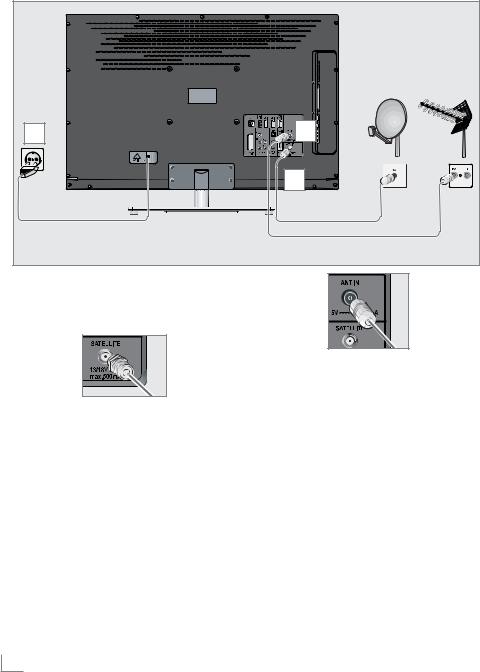
Connection and preparation------------------------------------------------
Connecting the antenna and power cord
3 |
2 |
|
1 |
1To receive digital satellite channels (DVB-S), connect the satellite antenna cable to the antenna socket »SATELLITE« on the television set.
And/or:
2a To receive terrestrial digital broadcasters
(DVB-T) connect the cable for the rooftop or indoor antenna (passive or active indoor antenna with its own power supply) to the an-
tenna socket »ANT IN« on the television set; or
2b To receive digital cable channels (DVB-C) connect the cable for the rooftop antenna to the antenna socket »ANT IN« on the
television set; or
2c To receive analogue TV channels, connect the cable for the rooftop antenna to the antenna socket »ANT IN« on the television set
Note:
7When connecting an indoor antenna you may have to try it out at different positions until you get the best reception.
3 Plug the power cord into a wall socket.
Note:
7Do not plug in the power cord of the device until you have connected the external equipment and the antenna.
7Only use the power cord supplied to connect
the television set to a suitable earthed safety socket.
7Do not use an adapter plug or extension lead which does not meet the applicable safety standards. Do not tamper with the power cord.
8 ENGLISH
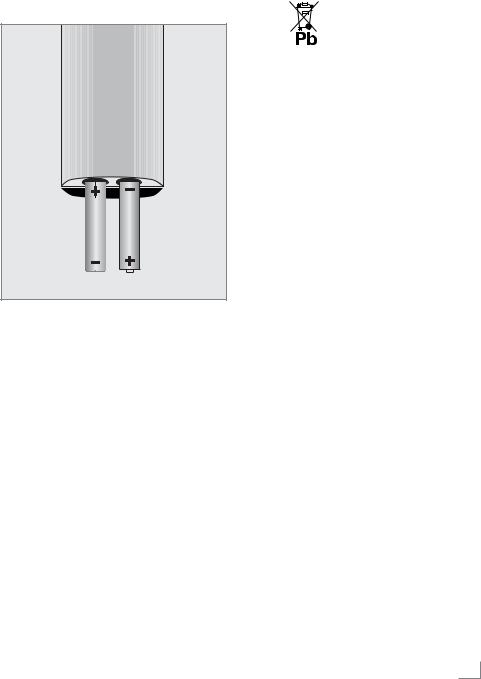
Connection and preparation------------------------------------------------
Inserting batteries into the remote control
1Open the battery compartment by removing the lid.
2Insert the batteries (2 x 1.5 V micro, for example R03 or AAA). Observe the polarity marked in the bottom of the battery compartment .
3 Close the battery compartment.
Note:
Environmental note
7 |
|
|
|
|
|
|
This symbol on recharge- |
|
|
|
|
|
|
able batteries/batteries or |
|
|
|
|
|
|
|
|
|
|
|
|
|
|
|
|
on the packaging indicates |
|
|
|
|
|
|
|
that the rechargeable bat- |
|
|
|
|
|
|
|
|
|
tery/battery may not be disposed of with |
||||||
|
regular household rubbish. For certain |
||||||
rechargeable batteries/batteries, this symbol may be supplemented by a chemical symbol. Symbols for mercury (Hg) or lead (Pb) are provided if the rechargeable batteries/batteries contain more than 0.0005% mercury or more than 0.004% lead.
Rechargeable batteries/batteries, including those which do not contain heavy metal, may not be disposed of with household waste. Always dispose of used batteries in accordance with local environmental regulations. Make enquiries about the applicable disposal regulations where you live.
7If the television no longer reacts properly to remote control commands, the batteries may be flat. Always remove used batteries.
7The manufacturer accepts no liability for damage caused by leaking batteries.
ENGLISH 9
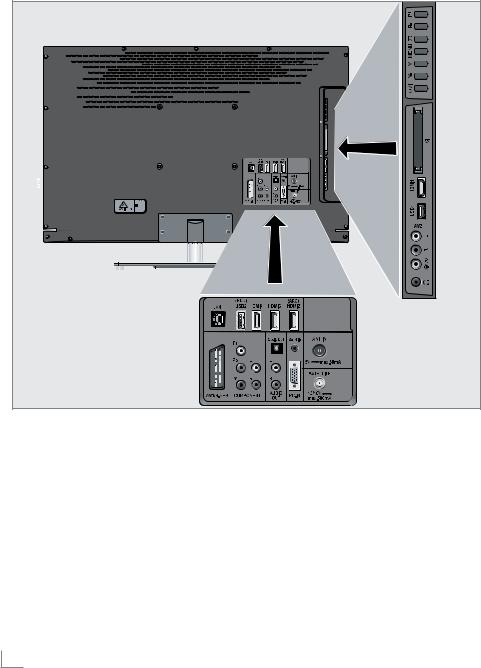
Overview-------------------------------------------------------------------------------------------------------------------------------------
Connections on the television set
AV1 / S-VHS |
|
|
|
|
|
|
|
|
|
|
|
|
|
|
|
|
|
|
|
|
|
|
|
|
|
|
|
|
|
|
|
|
|
|
|
|
|
|
|
|
|
|
|
|
|
|
|
|
|
|
|
|
|
|
|
|
|
|
|
|
|
|
|
|
|
|
|
|
|
|
|
|
|
|
|
|
|
|
|
|
|
|
|
|
|
|
|
|
|
|
|
|
|
|
|
|
|
|
|
|
|
|
|
|
|
|
|
|
|
|
|
|
|
|
|
|
|
|
|
|
|
|
|
|
|
|
|
|
|
|
|
|
|
|
|
|
|
|
|
|
|
|
|
|
|
|
|
|
|
|
|
|
|
|
|
|
|
|
|
|
|
|
|
|
|
|
|
SCART socket (CVBS signal, |
|
||||||||||||
|
RGB signal); |
|
|||||||||||
|
Video and sound socket for |
|
|||||||||||
|
S-Video camcorder. |
|
|||||||||||
COMPONENT |
|
|
|
|
|
|
|
|
|
|
|
|
|
Y Pb Pr |
Sockets for video input |
|
|||||||||||
|
(YUV signal). |
|
|||||||||||
L R |
Sockets for audio input |
|
|||||||||||
|
(YUV signal). |
|
|||||||||||
Optic Out |
Socket for audio output |
|
|||||||||||
|
(optical) for PCM/AC3 |
|
|||||||||||
|
signals. |
|
|||||||||||
|
For connecting digital AV |
|
|||||||||||
|
amplifiers or AV receivers. |
|
|||||||||||
AUDIO OUT L R Sockets for audio output.
Audio |
Socket for audio |
|
input for a PC. |
PC-IN |
VGA socket, video input |
|
for PC. |
SATELLITE |
Antenna socket for the |
|
satellite antenna (DVB-S). |
ANT IN |
Antenna socket for a DVB-T, |
|
DVB-C and analogue |
|
antenna. |
10 ENGLISH

Overview-------------------------------------------------------------------------------------------------------------------------------------
HDMI2 (ARC) |
HDMI socket, |
|
audio/video input. |
HDMI3 |
HDMI socket, |
|
audio/video input. |
HDMI4 |
HDMI socket, |
|
audio/video input. |
USB2 (HDD) |
USB socket for external |
|
data media and |
|
PVR function. |
LAN |
Network cable connection |
|
socket. |
UHeadphone jack (3.5 mm jack plug);
Sockets for audio output.
AV2 |
|
Video |
Video socket for |
|
camcorder |
L R |
Audio socket for |
|
camcorder. |
USB1 |
USB socket for external |
|
data media without a power |
|
supply of their own and |
|
PVR function. |
HDMI1 |
HDMI socket, |
|
audio/video input. |
CI |
Common Interface Slot. |
Controls on the television set
8/I |
Switches the television on and |
|
back into standby mode. |
V– V+ |
Adjusts the volume; |
|
selects menu functions. |
MENU |
Opens the menu. |
|
Select a menu option with |
|
»P+« or »P–«. |
|
Activate the function with |
|
»V+«. |
|
Confirm the function with |
|
»V+« or »V–«.. |
|
Press »MENU« to quit the menu. |
SOURCE |
Opens the pre-selection for |
|
AV channels. |
|
In the menu, press »P+« or »P–« |
|
to select and press »SOURCE« to |
|
confirm. |
P– P+ |
Switches the television on from |
|
standby; |
|
selects channels in steps; |
|
selects function in the menu. |
ENGLISH 11
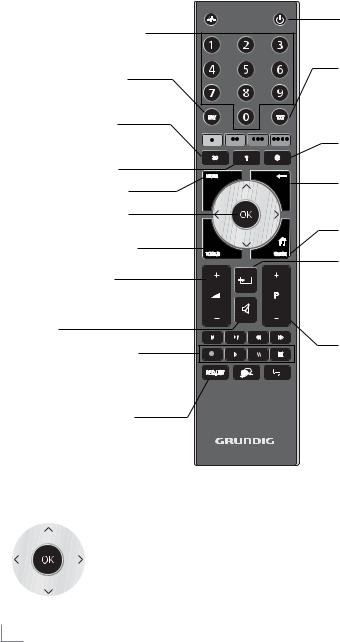
Overview-------------------------------------------------------------------------------------------------------------------------------------
The remote control – Main functions
Switches on from standby; Selects channel – directly.
Selects the channel list (»All«, »FAV 1« to »FAV 4«).
Key has no function.
Switches on and off |
(Standby). |
Switches between |
teletext and TV mode; |
opens/closes the control |
menu when playing a file in |
DLNA menu. |
|
Opens the Smart inter@ctive |
|
Displays information. |
menu. |
|
|
||
Opens the main menu. |
Zapping function; |
|
switches back one menu |
||
|
||
Opens the channel list. |
level in the menus. |
|
|
Opens the electronic |
|
Opens the TOOLS menu. |
TV guide. |
|
Opens menu for AV channels |
||
|
||
Adjusts the volume. |
and USB input. |
|
|
Then select using »V«, »<«, |
|
|
»>« or »Λ« and press »OK« |
|
Muting |
to confirm. |
|
|
||
Record, play, pause and |
Switches on from standby; |
|
Selects channel – in steps. |
||
stop (only digital television |
||
|
||
channels) on/from an exter- |
|
|
nal data medium. |
|
|
Opens the »PRnP« menu. |
|
Navigation in the menus
Moves the cursor up and down in the menus.
Moves the cursor to the left and right in the menus.
Activates various functions and save functions/settings.
12 ENGLISH

Overview-------------------------------------------------------------------------------------------------------------------------------------
The remote control –
All functions
RSwitch on button lighting. The lighting switches off automatically after a short time.
@Opens the Smart inter@ctive menu.
(red) |
Selects pages in teletext; |
(green) |
Selects/activates various functions |
(yellow) in the menus.
(blue)
5Selects different audio settings; Switches to double character size in teletext;
Selects the next title/next picture in the file browser.
6Selects different picture settings; Refreshes a teletext page;
Selects the previous track/previous picture in the file browser.
3Stops scrolling through pages in teletext;
Starts a fast reverse search in the file browser.
4Selects the channel list ( »All«, »FAV 1« to »FAV 4«);
Reveals answers in teletext; Starts a fast forward search in the file browser.
Starts the recording (only for digital television channels, the recording is made on an external data medium).
8Starts playing a programme from an external data medium; Repeats a recorded programme; Starts playing in DLNA and vTuner menu.
!Freeze frame, if no external data medium is connected;
Playback pause;
Time shift mode (only for digital television channels and when an external data medium is connected);
Pauses the file being played in DLNA and vTuner menu.
7Ends playback of a programme from an external data medium; Ends a recording or
playback in time shift mode; Splits the screen in teletext;
Ends playing in DLNA and vTuner menu.
Selects different audio languages
(only for digital television channels)
Selects different subtitles
(only for digital television channels)
Note:
7Your TV supports remote control feature for Apple iPhones and Android phones. Depending on the features of your TV, you may control your TV by your phone after downloading the free »GRUNDIG TV Remote« application from Apple App. Store or Android Market and install it on the Apple iPhone/Android phone.
ENGLISH 13

Settings------------------------------------------------------------------------------------------------------------------------------------------
Initial set-up and tuning television channels
The television set is equipped with automatic channel search, which searches for satellite channels (DVB-S), terrestrial channels (DVB-T), cable channels (DVB-C) and analogue channels.
You start the search and the television channels will be stored into the Program Table. Following, you can sort the television channels in the Program Table.
For DVB-S channels there are 6000 presets available, for DVB-T and DVB-C channels 1000 presets, and 99 presets for analogue channels.
The various settings
Depending on the type of antenna connected, you can decide which channels you would like the television to search for.
7Tunes digital television channels from the satellite, from page 15.
You have two options for this search:
–the basic installation which presets a standard selection, e.g. the satellite Astra 19.2° East; you need only start the search;
–the professional installation, which allows you to make all required settings and set parameters for your receiver system.
7Tunes digital terrestrial television channels, on page 17.
7Tunes digital television channels from the cable provider, on page 17.
7Tunes analogue television channels, in the chapter “Special functions”, starting on page 73.
7Further settings for digital television channels after the initial set-up can also be found in the chapter “Special Settings”, starting on page 66.
Note:
Selecting language, country and operating mode
1Switch on the television set from standby with »8«, »1…0« or »P+« or »P-«.
–During initial set-up, the »Installation Guide« will be displayed.
Help:
7If this menu is not displayed, restore the television set to its default settings (see page 56).
2Select the menu language with »<«, »>«, »V« or »Λ« and press »OK« to confirm.
3Select the mode with »<« or »>« and press »OK« to confirm.
–The settings used in »Home Mode« help to save energy.
–Alternatively, the menu item »Shop Mode« can be selected which the retailer can use for demonstrating the device functions.
Note:
7End the »Shop Mode« by restoring the television set to its default settings (see page 56).
4Select the country in which the television set is operated with »<«, »>«, »V« or »Λ« and press »OK« to confirm.
–The »Source Setup« menu appears with the »Connection Type« line marked.
Note:
7You can find a description of how to tune the television channel of your choice – depending on the antenna connected – in the following chapters.
7Make the language and country selection for all types, then continue reading the respective chapter.
14 ENGLISH
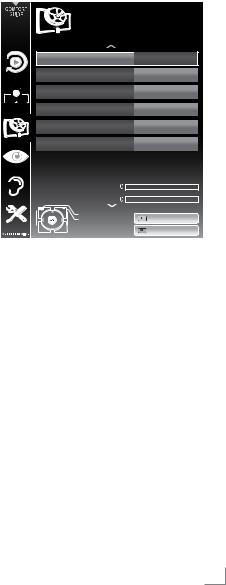
Settings------------------------------------------------------------------------------------------------------------------------------------------
Tuning the television channels from satellite (DVB-S)
You have two options for tuning digital satellite channels.
A The easy installation,
which pre-configures all antenna settings for the satellite channels on Astra 19.2° East.
B The advanced installation
can be used if you wish to receive satellite channels from various satellites. To do so, you must make the antenna settings (Satellite, LNB Power, LNB Type, DISEqC Mode, LNB Selection) for the satellites chosen.
Easy installation
1In the »Source Setup« menu, in the »Connec-
tion Type« line, select the option »Satellite« with »<« or »>«.
2Select the line »Easy Installation« with »V« or »Λ« and press »OK« to confirm.
–Other menu options will be displayed, the satellite Astra 19.2° East is preset.
3Start the scan with »« (green).
–The »Search results« menu appears, and the scan for TV channels begins.
–Depending on the number of television channels received, this can easily take a few minutes.
–The scan is complete as soon as the »PROGRAM TABLE« appears.
Note:
7You can abort the scan by pressing »MENU«.
Advanced installation
1In the »Source Setup« menu, in the »Connec-
tion Type« line, select the option »Satellite« with »<« or »>«.
2Select the line »Advanced Installation« with »V« or »Λ« and press »OK« to confirm.
– The menu appears.
20.07.2011
INSTALLATION 15:46
ANTENNA SETTINGS
Satellite |
ASTRA 2A°,E |
Transponder |
10714 |
LNB Power |
Off |
LNB Type |
Universal |
DISEqC Mode |
Off |
LNB Selection |
Off |
Low |
Normal Good |
Quality |
|
Signal strength |
|
Exit |
Auto Tuning |
Back |
|
|
Manual Tuning |
3Select the line »Satellite« with »V« or »Λ« and press »OK« to confirm.
– The »SELECT SATELLITE« menu appears. Select the satellites with »V«, »Λ«, »<« or »>« and press »OK« to confirm.
Note:
7The setting in the line »Transponder« is not required for this automatic scan.
4Select the line »LNB Power« with »V« or »Λ«.
Depending on the type of LNB, set the LNB
power supply to »13/18 V« or »14/19 V« with »<« or »>«.
5Select the line »LNB Type« with »V« or »Λ«. Select the type of LNB installed with »<« or »>«.
ENGLISH 15
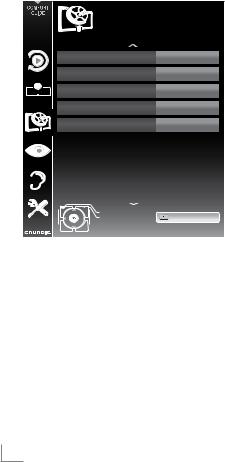
Settings------------------------------------------------------------------------------------------------------------------------------------------
6Select the line »DISEqC Mode« with »V« or »Λ«.
Select »DiSEqC 1.0« or »DiSEqC 1.1« in
accordance with the existing antenna system with »<« or »>«.
–DiSEqC 1.0 allows up to four satellites to be received simultaneously.
–DiSEqC 1.1 allows up to 16 satellites to be received simultaneously.
7Select the line »LNB Selection« with »V« or »Λ«.
Select the setting for the respective satellites with »<« or »>«.
8Once the settings for the satellite have been made, switch to the »AUTOMATIC CHANNEL SEARCH« menu with »« (red).
20.09.2010
SOURCE SETUP 15:46
AUTOMATIC CHANNEL SEARCH
Connection Type |
Satellite |
Select Satellite |
ASTRA 2A , E |
Scan Mode |
Free + Scramble |
Service Type |
All |
Network Search |
Off |
|
|
Exit |
Start Search |
|
|
Back |
|
9 |
Select |
the line »Scan |
Mode« with »V« |
|
or »Λ«. |
|
|
|
Select the scan mode with »<« or »>« |
||
|
(for unencrypted channels, for encrypted |
||
|
channels only, or for both). |
||
10 |
Select |
the line »Service Type« with »V« |
|
|
or »Λ«. |
|
|
|
Use »<« or »>« to select whether you |
||
|
want to search for television channels only |
||
|
(TV), radio stations only (Radio) or both |
||
|
(Radio |
+ TV). |
|
11Start the scan with »« (red).
–The »Results« menu appears, and the scan for TV channels begins.
–Depending on the number of television channels received, this can easily take a few minutes.
–The scan is complete as soon as the »PROGRAM TABLE« appears.
Note:
7You can abort the scan by pressing »MENU«.
12 Press »MENU« to end the setting.
Note:
7If other television channels are to be tuned from a second satellite, proceed as follows:
Open the menu with »MENU«, select the line »SOURCE SETUP« with »V« or »Λ« and press »OK« to confirm. Then select the »Automatic Channel Search« with »V« or »Λ« and press »OK« to confirm. Confirm the line »Select Satellite« with »OK« and
select the preferred satellite with »V«, »Λ«, »<« or »>«. Start the scan with »« (red). Continue the adjustment by step 7 of the chapter.
Note:
7Before recording HD channels, please check signal quality and Strength, see chapter "Displaying signal information" on page 76. If the level is displayed in green, you can record HD channels without any problems.
16 ENGLISH

Settings------------------------------------------------------------------------------------------------------------------------------------------
Tuning terrestrial television channels (DVB-T)
1In the »Source Setup« menu, in the »Connec-
tion Type« line, select the option »Air« with »<« or »>«.
2Select the line »Scan Type« with »V« or
»Λ«.
Usetype:»<« or »>« to set the required scan
–»DTV«, scan for digital television channels;
–»ATV«, scan for analogue television channels;
–»ATV & DTV«, scan for analogue and digital television channels.
Caution:
7The antenna power supply (5V  ) may only be switched on if the antenna is an active indoor antenna with a signal amplifier and it is not already supplied with a voltage via a mains plug (or similar supply). Otherwise you may cause a short circuit and irreparably damage your antenna.
) may only be switched on if the antenna is an active indoor antenna with a signal amplifier and it is not already supplied with a voltage via a mains plug (or similar supply). Otherwise you may cause a short circuit and irreparably damage your antenna.
3Select the line »Active Antenna Power« with »V« or »Λ«.
Switch on the antenna power supply for the antenna with »<« or »>« (»On«).
4Start the scan with »« (green).
–The »Search Results« menu appears, and the search for TV channels begins.
–Depending on the number of television channels received, this can easily take a few minutes.
–The scan is complete as soon as the »PROGRAM TABLE« appears.
Note:
7You can abort the scan by pressing »MENU«.
5 Press »MENU« to end the setting.
Note:
7Before recording HD channels, please check signal quality and Strength, see chapter "Displaying signal information" on page 76. If the level is displayed in green, you can record HD channels without any problems.
Tuning television channels from the cable provider (DVB-C)
1In the »Source Setup« menu, in the »Connec-
tion Type« line, select the option »Cable« with »<« or »>«.
2Select the line »Scan Type« with »V« or »Λ«. Use »<« or »>« to set the required scan type:
–»DTV«, scan for digital television channels;
–»ATV«, scan for analogue television channels;
–»ATV & DTV«, scan for analogue and digital television channels.
3Select the line »Cabel Scan Type« with »V«
or »Λ«. Select the preferred option (»Quick« or »Full«) with »<« or »>«.
–The search function »Quick« sets up the channels according to the information provided by your cable provider in the transmission signal.
–If the option »Full« is selected, the entire frequency range will be scanned. The search can take a long time with this option. This option is recommended if your cable provider does not support the scan type »Quick«.
Note:
7You can accelerate the search. To do this, you need information about the frequency and network ID. You are usually able to get this data from your cable operator or find it in forums on the Internet.
4Start the scan with »« (green).
–The »Search Results« menu appears, and the search for TV channels begins.
–Depending on the number of television channels received, this can easily take a few minutes.
–The scan is complete as soon as the »PROGRAM TABLE« appears.
Note:
7You can abort the scan by pressing »MENU«.
5 Press »MENU« to end the setting.
Note:
7Before recording HD channels, please check signal quality and Strength, see chapter "Displaying signal information" on page 76. If the level is displayed in green, you can record HD channels without any problems.
ENGLISH 17
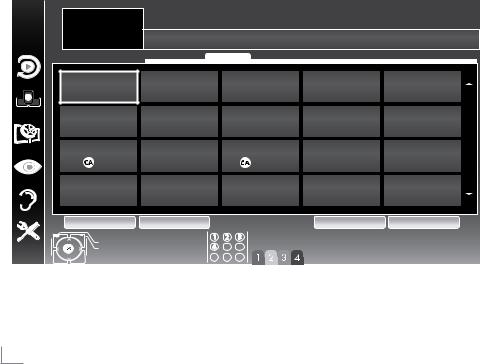
Settings------------------------------------------------------------------------------------------------------------------------------------------
Changing the program table for the digital channels
Channels which are found using the scan are saved in the »PROGRAM TABLE«.
You can delete channels which are not required from the programe table, you can change the order of channels within the programe table and lock individual channels (Parental control).
You can also add channels to the favourites list; in addition, you can change the order of channels within the favourites list.
With »« (green) you can display the channels which belong to one network.
Switch to the next page in the programe table with »P+« and to the previous page with »P-«.
With »« (yellow) you can open the »LIST MANAGEMENT« within the programe table.
In this List Management you can create your own favourites lists.
With »« (blue) you can sort the channels according different criteria.
Selecting channel lists
1 Open the menu with »MENU«.
2Select the »SOURCE SETUP« menu with »V« or »Λ« and press »OK« to confirm.
– The »SOURCE SETUP« menu appears.
3Select the line »Programe Table« with »V« or »Λ« and press »OK« to confirm.
– The menu »PROGRAM TABLE« appears.
Important:
7Programe table and favourites lists are saved separately according to the different input sources (satellite, cable, air).
7When opening the programme table, the respective channel list for the current input signal appears .
Note:
7If in the Program Table  appears added to the name of the channel, you need a CI module and a Smart-Card for watching these channels.
appears added to the name of the channel, you need a CI module and a Smart-Card for watching these channels.
INSTALLATION |
|
PROGRAM TABLE |
Network ALL |
|
|
1 Das Erste HD |
|
Service ALL
1 Das Erste HD |
2 |
ZDF HD |
3 |
arte HD |
4 |
N24 |
5 Einsfestival |
DTV |
DTV |
|
DTV |
|
DTV |
|
DTV |
6 EinsPlus |
7 |
arte |
8 |
Phoenix |
9 |
Test-R |
10 ANIXE HD |
DTV |
DTV |
|
DTV |
|
DTV |
|
DTV |
11 HD 1 |
12 Life |
13 Film |
14 Promo |
15 Sport1 |
|||
DTV |
DTV |
DTV |
DTV |
DTV |
|||
16 TV Sport |
17 Sat.8 |
18 SKY |
19 TV6 |
20 TV5 |
|||
DTV |
DTV |
DTV |
DTV |
DTV |
|||

 Edit
Edit 
 Network
Network 
 Add To Fav.
Add To Fav. 
 Sort
Sort
Exit |
Select Favorite |
Back |
|
18 ENGLISH

Settings------------------------------------------------------------------------------------------------------------------------------------------
Deleting channels
1In the »PROGRAM TABLE« menu, select the Edit mode by pressing »« (red).
2 Select the television channel to be deleted
with »V«, »Λ«, »<« or »>« and press »« (yellow) to delete.
Note:
7You can delete all channels with »« (blue).
3Confirm the deletion process with »« (green);
or
cancel the deletion process with »« (red);
4 Quit the program table with »MENU«.
Change the order of the channels in the program table
1In the »PROGRAM TABLE« menu, select the Edit mode by pressing »« (red).
2Select the channel which should be moved with »V«, »Λ«, »<« or »>« and mark it with »« (red).
3Move the channel to its new position with »V«, »Λ«, »<« or »>« and press »OK« to confirm .
Note:
7Repeat steps 2 and 3 if you would like to change other channels.
4 Quit the program table with »MENU«.
Sorting channels in the program table
You can sort the order of the channels in the program table according different criteria: in order of Satellite, alphabetical or in order of encryptied/free channels.
1In the »PROGRAM TABLE« menu, select the Sort mode by pressing »« (blue).
2Select the sort criteria with »« (red), »« (green) or »« (yellow).
3 Quit the program table with »MENU«.
Skipping channels
You can mark television channels which should be skipped when selecting with »Λ« or »V«. It is still possible to select them using the number buttons.
1In the »PROGRAM TABLE« menu, switch over to the list view with »« (yellow).
2 Select the preferred channel with »V« or »Λ«.
3Select the column »Skip« with »<« or »>« and use »OK« to mark the channel.
– The channel is marked by » «.
4 Quit the program table with »MENU«.
Note:
7Channels can also be reactivated. Select the channel with »V« or »Λ«, then select the column »Skip« and reactivate the channel with »OK«.
Creating lists of favourites
You can save your favourite channels in up to four favourites lists (FAV 1 to FAV 4).
Notes:
7Favourites lists must be created separately for all input sources (satellite, cable, air).
7You can select the favourites list by pressing »FAV«.
1 In the »PROGRAM TABLE« menu, switch over to the list view with »« (yellow).
2Select the channel of your choice with »V« or »Λ«.
3 “Push” the channel into the favourites lists 1 to 4 with »<« or »>« and press »OK« to confirm.
–The position in the favourites list is marked with » «.
–You can enter the same channel in more than one favourite list.
–Each favourite list can store up to 255 channels.
ENGLISH 19

Settings------------------------------------------------------------------------------------------------------------------------------------------
Note:
7Channels can also be deleted from the
favourites lists. Select the channel to be deleted with »V«, »Λ«, »<« or »>« and press »OK« to delete it.
7When deleting a channel from the favourites list, the order within the favourites list will be updated.
4 Quit the program table with »MENU«.
Sorting channels in the favourite list
You can change the order of channels in the favourites list.
1In the »PROGRAM TABLE« menu, select the favourites list »1« to »4«.
2Select the channel which should be moved with »V«, »Λ«, »<« or »>« and mark it with »« (red).
3Move the channel to its new position with »V«, »Λ«, »<« or »>« and press »OK« to confirm .
Notes:
7Repeat steps 2 and 3 if you would like to change other channels within the same favourites list.
7Repeat steps 1 to 3 if you would like to change channels in a different favourites list.
4Exit the current favourites list with »« (blue).
–The entire programe table will appear again.
5 Quit the program table with »MENU«.
Enter own names for the favourites lists (max. 6 characters)
You can enter own names for all favourites lists.
1In the »PROGRAM TABLE« menu, switch over to the list view with »● ● ●« (yellow).
2Select the desired favourites list with »1« till »4«.
– The Favorite Name screen is displayed.
3Delete the „old“ name (FAV1), for this purpose select with »V«, »Λ«, »<« and »>« the push button »x« and delete the character with »OK«.
4Select the required character/numeric with »V«, »Λ«, »<« and »>« and confirm with »OK«.
Repeat the procedure for further characters/ numerics.
–Select »ABC« for uppercase and »abc« for lower case and confirm with »OK«.
–Select »?@123« for numbers and symbols and confirm with »OK«.
5Confirm the new name, select the push
button »Submit« with »V«, »Λ«, »<« or »>« and confirm with »OK«.
6 Press »MENU« to end the seting.
20 ENGLISH
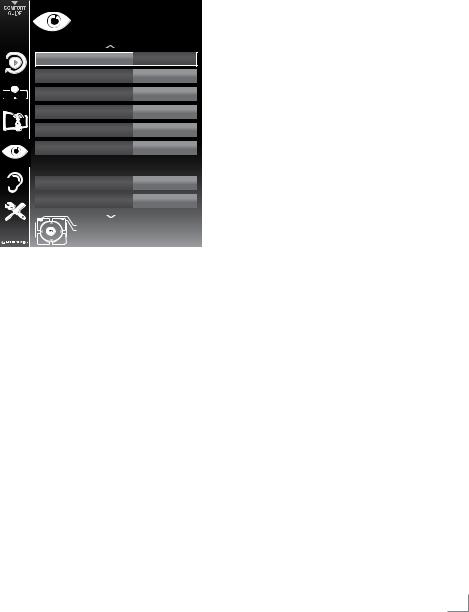
Settings------------------------------------------------------------------------------------------------------------------------------------------
Picture settings
1 Open the menu with »MENU«.
2Select the menu item »PICTURE SETTINGS« with »V« or »Λ« and press »OK« to confirm.
– The »PICTURE SETTINGS« menu appears.
20.09.2010
15:46
PICTURE SETTINGS
Picture Mode |
User |
Brightness |
50 |
Contrast |
100 |
Sharpness |
75 |
Colour |
65 |
Colour Temperature |
Normal |
Advanced Tuning |
|
DNR |
Off |
MPEG NR |
Off |
Exit |
|
Back |
|
3Select the line »Picture Mode«, »Brightness«, »Contrast«, »Sharpness«, »Colour«, or
»Colour Temperature« with »V« or »Λ«. Select the value with »<« or »>« and press »OK« to confirm.
Notes:
7When changing the values with »<« or »>«, the screen will be split. You can see the current picture value on the left side, the new setting on the right side.
7In the »PICTURE SETTINGS« menu you can also find other additional settings.
4Select the line »DNR«, »Mpeg NR«, »Vibrant Colour«, »Perfect Clear«, »Film Mode«, »Gamma«, »Dynamic Contrast«, »Dynamic Backlight«, »Backlight« or »MEMC« with
»V« or »Λ«.
Select the value with »<« or »>« and press »OK« to confirm.
Notes:
7You can only select the »Mpeg NR« function on digital and AV presets.
»Mpeg NR« reduces any interference from artefacts (pixel blocks) from digital programmes due to MPEG compression (such as from DVB-T receivers or DVD players).
7The »Film Mode« detects and processes feature films automatically for all channel sources. This means you will always receive an optimal picture.
This functions in the modi 480i, 576i and 1080i in TV playback and for other channel sources.
If the »Film mode« is switched on for programmes without a feature film signal, minor problems such as picture freeze, defective subtitles or fine lines in the picture could occur .
7The function »Dynamic Contrast« adapts the contrast dynamically and optimally for the respective picture content.
7With »Dynamic Backlight«, the device optimally adapts the background lighting to the picture content.
7The »Backlight« can only be set manually when the function »Dynamic Backlight« is deactivated.
7»MEMC« will only appear in menus of LCD products with 200 Hz PPR Feature and LED products with 400 Hz PPR feature..
5 Press »MENU« to end the setting.
ENGLISH 21

Settings------------------------------------------------------------------------------------------------------------------------------------------
Sound settings
1 Open the menu with »MENU«.
2Select the menu item »SOUND SETTINGS« with »V« or »Λ« and press »OK« to confirm.
– The »SOUND SETTINGS« menu appears.
|
20.09.2010 |
|
SOUND SETTINGS |
15:46 |
|
|
||
Volume |
10 |
|
Balance |
|
|
|
|
|
|
|
|
Sound Type |
Stereo |
|
Sound Mode |
SRS TS HD |
|
SRS Sound Preset |
Speech |
|
External |
|
|
Headphone |
20 |
|
Audio Output Setup |
|
|
Accessibility Settings |
|
|
End |
|
|
Back |
|
|
Note:
7Additional operations are explained in the following sections.
Volume
1Select the line »Volume« with »V« or »Λ« and change the setting with »<« or »>«.
Balance
1Select the line »Balance« with »V« or »Λ« and change the setting with »<« or »>«.
Automatic volume
Television stations broadcast at different volumes. The automatic volume limiting (AVL) function means the volume is kept the same when you switch between channels.
1Select the line »AVL« with »V« or »Λ« and select the option »On« with »<« or »>«.
Note:
7If the »SRS TS HD« setting has been selected in the »Audio Mode« line, the AVL line cannot be selected.
Stereo/two channel sound, mono
If the device receives two-channel-sound programmes, e.g. a film with the original soundtrack on audio channel B (display: »Dual II«) and the dubbed version on sound channel A (display: »Dual I«), you can select the audio channel you prefer.
If the device receives stereo or Nicam programmes, it switches automatically to stereo sound (display: »Stereo«).
You can switch the sound to »Mono« if the stereo sound quality is poor.
1Select the line »Audio Type« with »V« or »Λ« and adjust the setting with »<« or »>«.
Stereo width
This broadens the sound output for stereo programmes and improves the sound with mono reception.
1Select the line »Audio Mode« with »V« or »Λ«.
2 Select the option »Spatial« with »<« or »>«.
22 ENGLISH

Settings------------------------------------------------------------------------------------------------------------------------------------------
Soundeffects
This menu offers three preset sound effects (Music, Natural and Speech) and one setting to be created by you (User).
1Select the line »Sound Preset« with »V« or »Λ«.
2Select the sound effect »Music«, »Natural« or »Speech« by pressing »<« or »>«.
Note:
7»User« option is active when »Sound mode« setting is selected as »Normal or »Spatial«.
SRS TruSurround HD
SRS TruSurround HD is a patented audio technology which is integrated into the television set and only requires the built-in speakers to generate a Surround Sound effect.
1Select the line »Sound Mode« with »V« or »Λ«.
2Select the option »SRS TS HD« with »<« or »>«.
3Select the line »SRS Sound Preset« with »V« or »Λ«.
4Select the sound effect »Music«, »Natural« or »Speech« with »<« or »>«.
Equalizer
Equalizer offers a sound setting ”User” that you can create.
Equaliser appears in the menu when »Sound mode« is selected as »Spatial« or »Normal«, and »Sound Medium« as »User«.
1Select »Equalizer« with »V« or »Λ« and press »OK« to confirm.
The »EqualiZer« menu appears.
Note:
7If the »SRS TS HD« setting has been selected in the »Sound Mode« line, the »Equalizer« line will not indicate.
2Select the frequency bandwidth »120Hz«
with »V« or »Λ«.
Set the preferred value with »<« or »>«.
3Set the next frequency bandwidth with »V« or »Λ« and repeat the setting.
4 Press »<« to save the setting.
Audio description (Audio subtitles)
Audio description is an additional audio channel for visually-impaired persons. Descriptions are provided of activities, surroundings, changes of scene, gestures and actors' facial expressions.
This audio channel is transmitted simultaneously with the normal sound on digital channels. Availability depends on the respective channel and broadcaster.
1Select the line »Audio Description« with »V« or »Λ« and select the option »On« with »<« or »>«.
2Select the line »Volume« with »V« or »Λ« and change the volume with »<« or »>«.
Exiting the setting
1 Press »MENU« to end the setting.
*Under licence from SRS Labs, Inc. TruSurround HD,
SRS and the  symbol are trademarks of SRS Labs, Inc.
symbol are trademarks of SRS Labs, Inc.
ENGLISH 23

Television - OPERATION--------------------------------------------------------------------------------
Basic functions
Switching on and off
1Press »8«, »1…0« or »P+« or »P-« to switch on the television from standby mode.
2 Press »8« to switch the television to standby.
Selecting channels
1 Press »1…0« to select presets directly.
2Select channels step by step with »P+« or »P-«.
3Open the channel list with »OK«, select the
preferred television channel with »V«, »Λ«, »<« or »>« and press »OK« to confirm. Exit the channel list with »MENU«.
Selecting channels from lists
You can select channels from various lists (e.g. all channels, FAV 1 to FAV 4).
1Press »FAV« to open an overview of programe tables.
– The overview is displayed.
2Select a channel list with »Λ« or »V« and open it with »OK«.
3Select a television channel with »V«, »Λ«, »<« or »>« and press »OK« to confirm.
4 Press »MENU« to exit the channel list.
Selecting a preset AV channel
1 Open the »Select Source« menu with » «.
«.
2Select an AV preset with »V«, »Λ«, »<« or »>« and press »OK« to confirm.
3Use »1…0« to switch back to the television channel.
Adjusting the volume
1 Adjust the volume with »+ O –«.
Switching sound on/off
1Press »P« to mute the sound or switch it on again.
Displaying information
1Display information, press »?« repeatedly.
–The display disappears automatically after a short while.
Freeze-frame
If you wish to view a particular scene for longer, you can “freeze” the frame of the current programme.
1 Activate the freeze-frame function with »$«. 2 End the freeze-frame function with »$«.
Note:
7If an external data medium is connected to the television, the time shift function is activated with »$«. The time shift function is described on page 41.
Picture settings
Various picture settings are available.
1 Open the Tools menu with »TOOLS«.
2Select the menu item »Picture Mode« with »V« or »Λ«.
3Select »User«, »Eco TV«, »Vivid«, »Natural«,
»Movie«, »Sports« or »Game« by pressing »<« or »>«.
–You can change the »User« picture setting; see “Picture settings” on page 21.
Note:
7Picture setting »Game« can only be selected in »HDMI«, »Component« and »PC« modes.
24 ENGLISH
